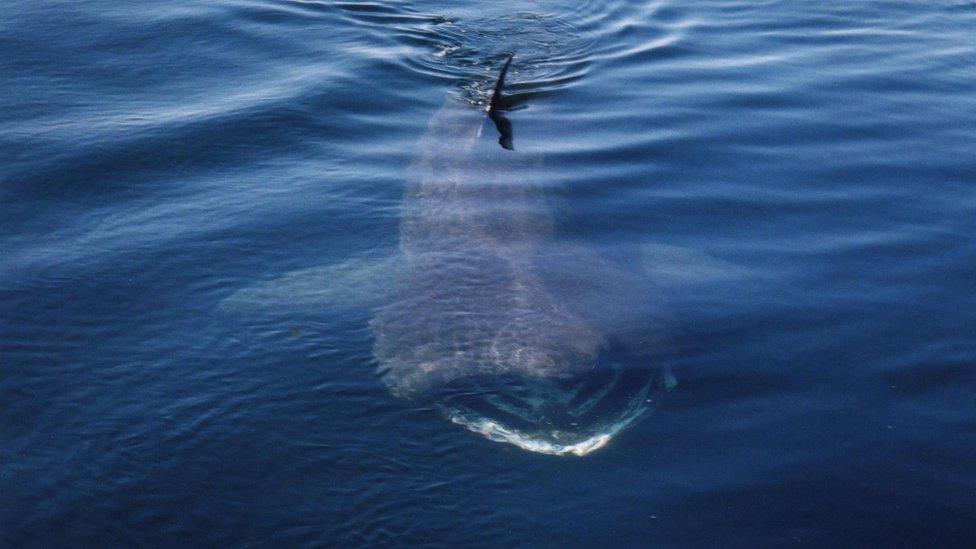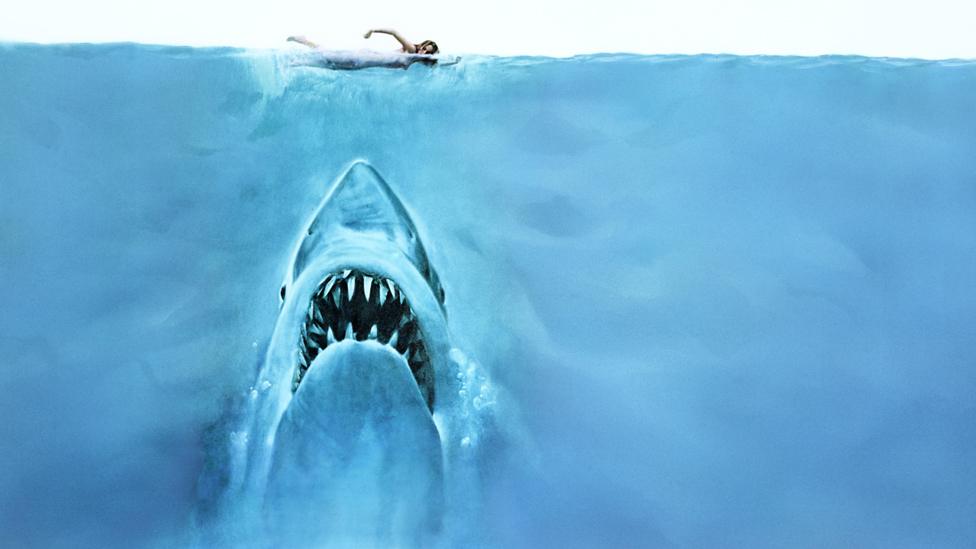The 'killer tiger shark' of Brighton beach
- Published

Shark scares are a well-established source of press stories. Did they start on Brighton beach in 1785?
The British seaside is not known for being dangerous. But during most summers the same fear returns - might a killer be lurking beyond the surf?
The Steven Spielberg film Jaws, in which a human-hungry great white terrorises a small New England resort, has encouraged this troubling sensation since its release 40 years ago. Shark stories have since become a staple for the British media.
In December a 10ft (3m) Mako shark, a species known to have killed three people from 1980 and 2010, washed up on Barmouth Beach, external, North Wales, to the delight of newspapers. A few months earlier, it was suggested a large shark seen off Cornwall was a great white, external - this turned out to be a harmless juvenile basking shark, external. And in 2007 tabloids reported that a great white could be hunting off St Ives, Cornwall - in fact this was the result of a prank, external.
It's fair to say the reporting of UK "spottings" of these creatures is out of proportion to any danger posed. So when did newspapers start cashing in on potentially life-threatening fish? September 1785 is one suggestion.

A basking shark off the coast of Scotland
On a warm afternoon, a man on Brighton (then called Brighthelmstone) beach, seeing the sea was calm, ventured in further than usual. "He had not been long diverting himself in the water," according to a letter printed in the Morning Herald newspaper, external, "before he heard a noise, and discovered the fins of a fish above the surface of the water, which he soon perceived approached him very fast."
The man ran back on to the beach, where "a large tiger shark plunged after him with that violence, that it forced itself entirely out of the water on dry land". The animal, with "no power of retreating", got stuck. The man gathered fellow beach-goers who hacked it to death with axes.

Brighton beach: Just when you thought it was safe to go into the water...
"On opening its stomach," the letter said, "the entire head of a man was found in it, not otherwise altered than being very soft and pappy, and the flesh and scalp entirely separating from the bone on touching it. The stomach was half an inch thick, and the shark was 12 feet in length from its head to its tail."
Unfortunately the body of the shark was reportedly thrown back in the English Channel, making it impossible to corroborate the account.
Still, it was convincing enough for The Times, which had started publication under its original title of the Daily Universal Register a few months earlier, to offer a handy guide to sharks for readers who had "never seen any of these formidable tygers of the deep". It advised that they had "no bones, but cartilages", adding that, according to fishermen who had caught them: "The shark is so vivacious as to move long after the head is cut off."
But could it really have been a tiger shark, so-called because of its stripy skin, that terrorised Brighton beach? "It's most unlikely," says John Turner, senior lecturer at Bangor University's school of ocean sciences, "but there's no doubt they can travel large distances and move out of warmer waters."

Tiger Sharks

Averaging 12ft in length, they can grow as large as 20ft
They enjoy tropical or sub-tropical waters, many being found in the seas around Hawaii
They operate as predators and scavengers
Sometimes described as a "garbage can with fins", tiger sharks have been found with tyres, clothing, coal and pieces of boats in their stomach
Sources: Sharks World and Shark Trust

Tiger sharks usually live in tropical and temperate seas, with no official sightings off the UK coast.
"It's difficult to know whether the identifications are correct," says Turner. "No doubt, if the shark has a little bit of dark lining, people will assume it's a tiger shark. Back in 1785 people weren't getting in the water as much, so their observations were probably not so good."
Author and veteran shark angler David Turner thinks the animal, if it existed, was more likely to have been a great white, never conclusively spotted in British seas but usually living in cooler waters than the tiger shark. They can kill people and jump out of the water.
"Great whites exist in water of a similar temperature in many parts of the world, such as off the east coast of America," he says. It would have to go "less off-course than a tiger shark" to end up at Brighton, he adds.
In the 1780s, global exploration was increasing, with Europeans coming into contact more often with land tigers. David Turner feels this could have influenced the description of the Brighton beast as a tiger shark. The great white was little known by the public.
Fear and awareness of sharks increased when Jaws, external, based on the novel of the same name by Peter Benchley, was released in 1975, eventually earning $471m (£310m), external. But the demonisation goes much further back.

Film poster artwork for Jaws (1975)
In 1679 scientists Angelo Pacichelli and Charles de Mariemont singled some sharks out as being motivated by a taste for human flesh. By 1845 American novelist Samuel Goodrich wrote that they were the "dread of mankind" where common. In Hawaii the term niuhi, meaning "man-eater", was used in native songs thought to refer to tiger sharks.
Interest in shark attacks increased after several people were fatally bitten off the coast of New Jersey in 1916, with Frederic Augustus Lucas of the American Museum of Natural History labelling the animal "mad".
Only 2,665 shark attacks on humans, external were recorded worldwide between 1580 and 2013, according to the Florida Museum of Natural History - 6.15 per year. Of these 492 were fatal.
Misreporting of shark incidents is a "recurring theme", says John Turner, because a human "is not a natural food source".
But tiger sharks are not to be taken lightly. "These large, blunt-nosed predators have a duly earned reputation as man-eaters", says National Geographic, external. "They are second only to great whites in attacking people. But because they have a near-completely undiscerning palate, they are not likely to swim away after biting a human, as great whites frequently do."
Some are calling for sharks to stop getting a bad press. "The dominant perception of intent-laden shark 'attacks' with fatal outcomes is outdated as a generic term and misleading to the public, external," say researchers Christopher Neff of the University of Sydney and Robert Hueter of Florida's Mote Marine Laboratory. They want people's understanding to "move beyond the 'Jaws effect'".
It might take a while.
Subscribe to the BBC News Magazine's email newsletter to get articles sent to your inbox.